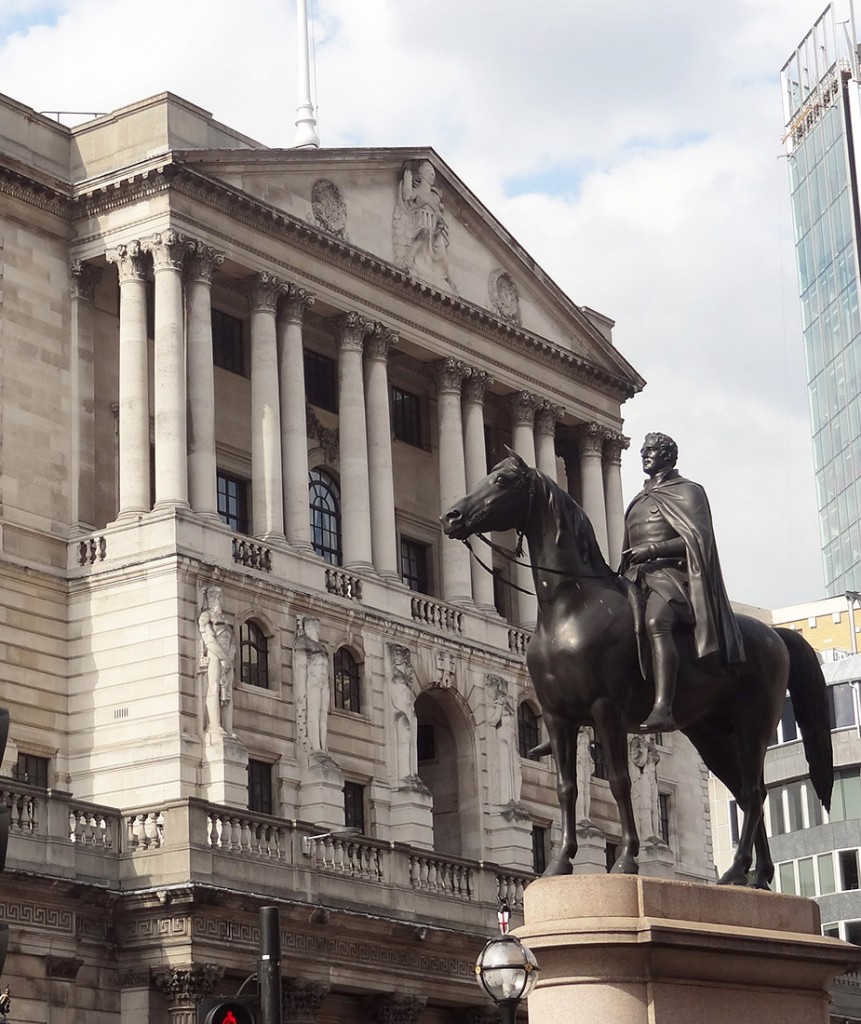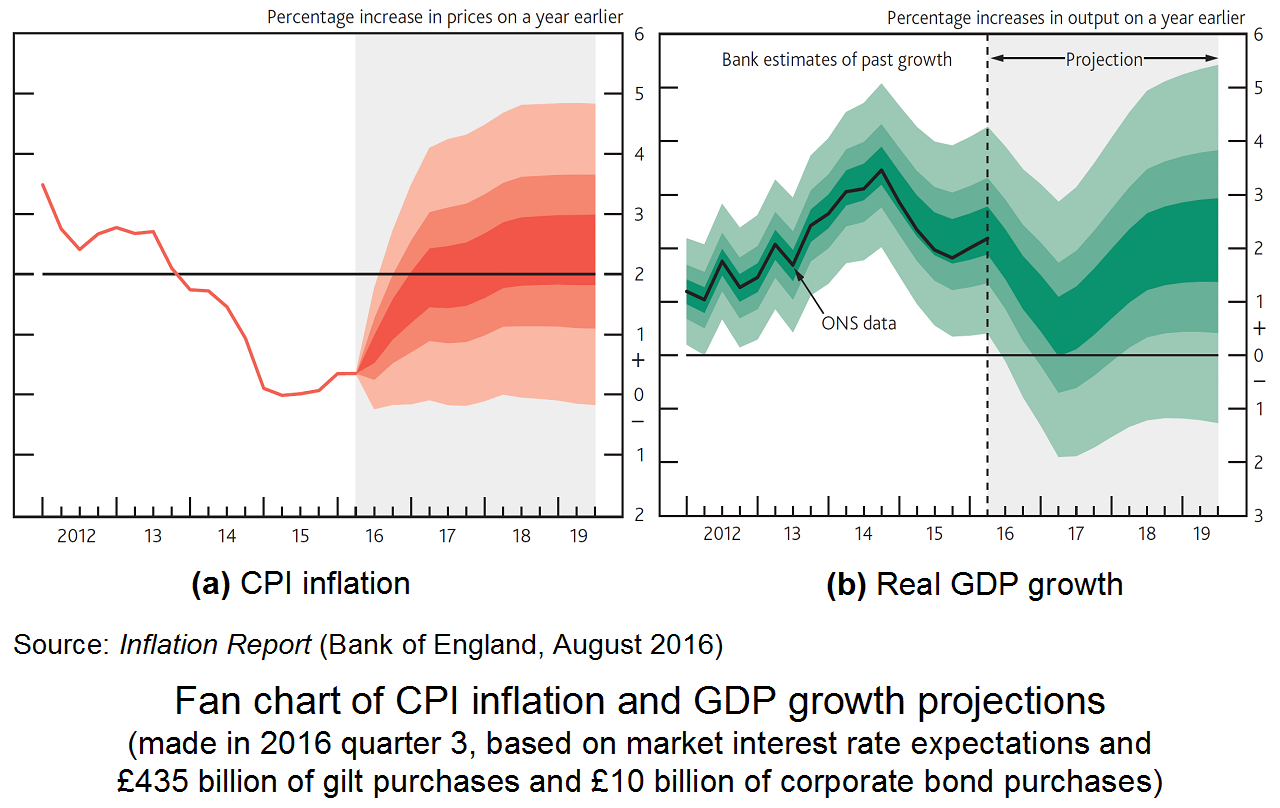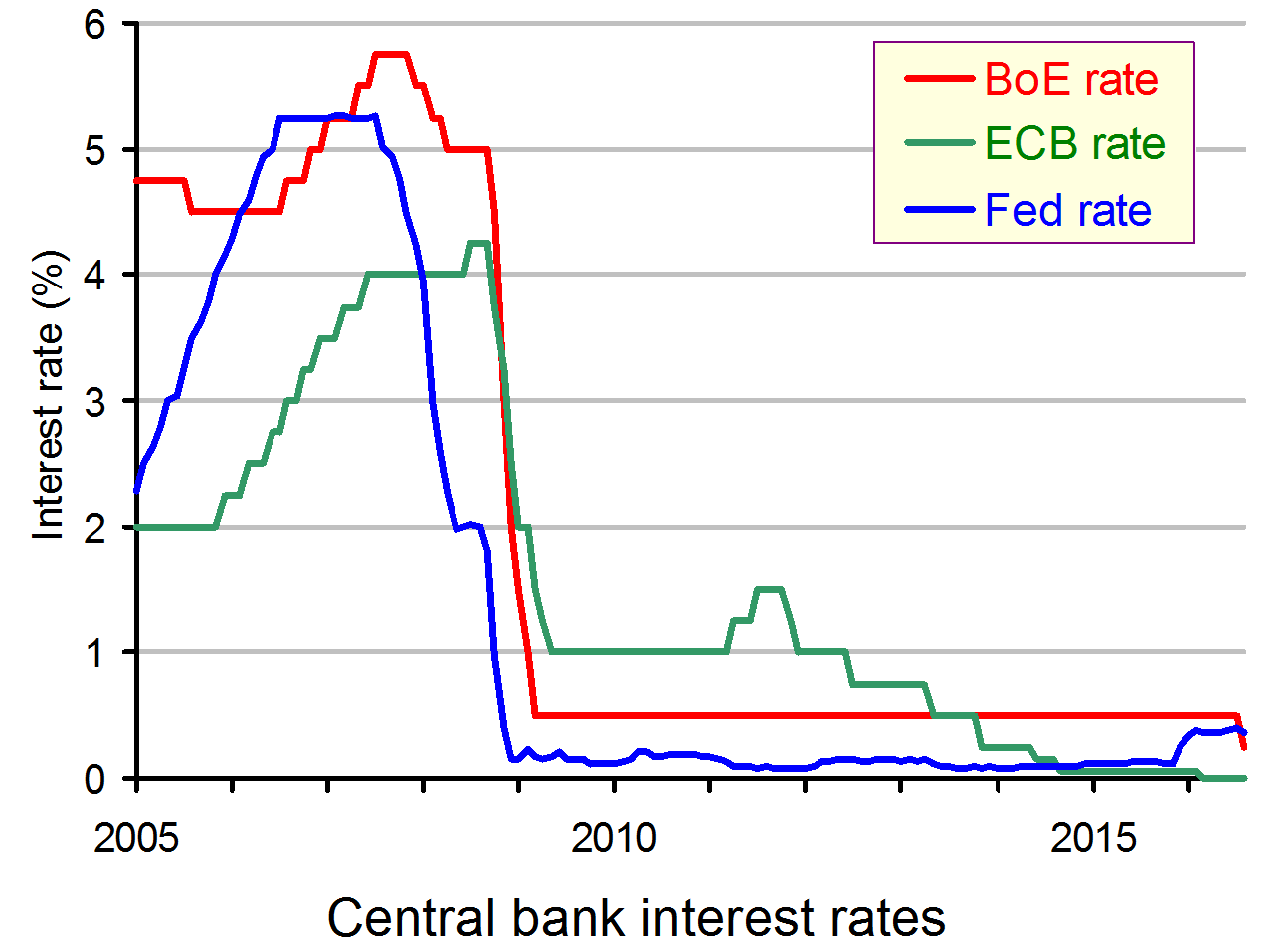 The Bank of England has responded to forecasts of a dramatic slowdown in the UK economy in the wake of the Brexit vote. On 4th August, it announced a substantial easing of monetary policy, but still left room for further easing later.
The Bank of England has responded to forecasts of a dramatic slowdown in the UK economy in the wake of the Brexit vote. On 4th August, it announced a substantial easing of monetary policy, but still left room for further easing later.
Its new measures are based on the forecasts in its latest 3-monthly Inflation Report. Compared with the May forecasts, the Report predicts that, even with the new measures, aggregate demand growth will slow dramatically. As a result, over the next two years cumulative GDP growth will be 2.5% lower than it would have been with a Remain vote and unemployment will rise from 4.9% to around 5.5%.
What is more, the slower growth in aggregate demand will impact on aggregate supply. As the Governor said in his  opening remarks at the Inflation Report press conference:
opening remarks at the Inflation Report press conference:
“The weakness in demand will itself weigh on supply as a period of low investment restrains growth in the capital stock and productivity.
There could also be more direct implications for supply from the decision to leave the European Union. The UK’s trading relationships are likely to change, but precisely how will be unclear for some time. If companies are uncertain about the future impact of this on their businesses, they could delay decisions about building supply capacity or entering new markets.”
Three main measures were announced.
| • | A cut in Bank Rate from 0.5% to 0.25%. This is the first time Bank Rate has been changed since March 2009. The Bank hopes that banks will pass this on to customers in terms of lower borrowing rates. |
| • | A new ‘Term Funding Scheme (TFS)’. “Compared to the old Funding for Lending Scheme, the TFS is a pure monetary policy instrument that is likely to be more stimulative pound-for-pound.” The scheme makes £100bn of central bank reserves available as loans to banks and building societies. These will be at ultra-low interest rates to enable banks to pass on the new lower Bank Rate to customers in all forms of lending. What is more, banks will be charged a penalty if they do not lend this money. |
| • | An expansion of the quantitative easing programme beyond the previous £375 billion of gilt (government bond) purchases. This will consist of an extra £60bn of gilt purchases and the purchase of up to £10bn of UK corporate bonds. |
 The Bank recognises that there is a limit to what monetary policy can do and that there is also a role to play for fiscal policy. The new Chancellor, Philip Hammond, is considering what fiscal measures can be taken, including spending on infrastructure projects. These are likely to have relative high multiplier effects and would also increase aggregate supply at the same time. But we will have to wait for the Autumn Statement to see what measures will be taken.
The Bank recognises that there is a limit to what monetary policy can do and that there is also a role to play for fiscal policy. The new Chancellor, Philip Hammond, is considering what fiscal measures can be taken, including spending on infrastructure projects. These are likely to have relative high multiplier effects and would also increase aggregate supply at the same time. But we will have to wait for the Autumn Statement to see what measures will be taken.
But despite the limits to monetary policy, there is more the Bank of England could do. It already recognises that there may have to be a further cut in Bank Rate, perhaps to 0.1% or even to 0% (the ECB has a 0% rate). There could also be additional quantitative easing or additional term funding to banks.
 Some economists argue that the Bank should go further still and, in conjunction with the Treasury, provide new money directly to fund infrastructure spending or tax cuts, or even as cash handouts to households. This extra money provided to the government would not increase government borrowing.
Some economists argue that the Bank should go further still and, in conjunction with the Treasury, provide new money directly to fund infrastructure spending or tax cuts, or even as cash handouts to households. This extra money provided to the government would not increase government borrowing.
We discussed the use of this version of ‘helicopter money’ in the blogs, A flawed model of monetary policy, Global warning and People’s quantitative easing. Some of the articles below also consider the potential for this type of monetary policy. In a letter to The Guardian 35 economists advocate:
A fiscal stimulus financed by central bank money creation [which] could be used to fund essential investment in infrastructure projects – boosting the incomes of businesses and households, and increasing the public sector’s productive assets in the process. Alternatively, the money could be used to fund either a tax cut or direct cash transfers to households, resulting in an immediate increase of household disposable incomes.
Webcasts and podcasts
 Inflation Report Press Conference Bank of England, Mark Carney (4/8/16)
Inflation Report Press Conference Bank of England, Mark Carney (4/8/16)
 Bank spells out chance of further rate cut this year BBC Radio 4 Today Programme, Ben Broadbent, Deputy Governor of the Bank of England (5/8/16)
Bank spells out chance of further rate cut this year BBC Radio 4 Today Programme, Ben Broadbent, Deputy Governor of the Bank of England (5/8/16)
 Broadbent Ready to Back Another BOE Rate Cut Amid Slowdown Bloomberg, Chris Wyllie (5/8/16)
Broadbent Ready to Back Another BOE Rate Cut Amid Slowdown Bloomberg, Chris Wyllie (5/8/16)
 What’s Top of Mind? ‘Helicopter Money’ Goldman Sachs Macroeconomic Insights, Allison Nathan (April 2016)
What’s Top of Mind? ‘Helicopter Money’ Goldman Sachs Macroeconomic Insights, Allison Nathan (April 2016)
Articles
Bank of England measures
Interest rate cut: What did the Bank of England announce today and how will it affect you? Independent, Ben Chu (5/8/16)
This is the Bank of England’s all-action response to Brexit The Guardian, Larry Elliott (4/8/16)
Bank of England unveils four-pronged stimulus package in bid to avoid Brexit recession The Telegraph, Szu Ping Chan (4/8/16)
Record-breaking Bank of England Financial Times, Robin Wigglesworth (4/8/16)
The Bank of England has delivered – now for a fiscal response Financial Times (4/8/16)
Bank of England Cuts Interest Rate to Historic Low, Citing Economic Pressures New York Times, Chad Bray (4/8/16)
Sledgehammer? This is more like the small tool to fix a fence The Telegraph, Andrew Sentance (5/8/16)
All eyes are on Hammond as Bank runs low on options The Telegraph, Tom Stevenson (6/8/16)
Bank of England’s stimulus package has bought the chancellor some time The Guardian, Larry Elliott (7/8/16)
Helicopter money
A post-Brexit economic policy reset for the UK is essential Guardian letters, 35 economists (3/8/16)
Cash handouts are best way to boost British growth, say economists The Guardian, Larry Elliott (4/8/16)
Helicopter money: if not now, when? Financial Times, Martin Sandbu (2/8/16)
The helicopters fly on for now, but one day they will crash The Telegraph, Tom Stevenson (23/7/16)
Is the concept of ‘helicopter money’ set for a resurgence? The Conversation, Phil Lewis (2/8/16)
Helicopter money talk takes flight as Bank of Japan runs out of runway Reuters, Stanley White (30/7/16)
Helicopters 101: your guide to monetary financing Deutsche Bank Research, George Saravelos, Daniel Brehon and Robin Winkler (15/4/16)
Helicopter money is back in the air The Guardian, Robert Skidelsky (22/9/16)
Bank of England publications
Inflation Report, August 2016 Bank of England (4/8/16)
Inflation Report Press Conference: Opening Remarks by the Governor Bank of England, Mark Carney (4/8/16)
Inflation Report Q&A Bank of England Press Conference (4/8/16)
Inflation Report, August 2016: Landing page Bank of England (4/8/16)
Questions
- Find out the details of the previous Funding for Lending (FLS) scheme. How does the new Term Funding Scheme (TFS) differ from it? Why does the Bank of England feel that TFS is likely to be more effective than FLS in expanding lending?
- What is the transmission mechanism between asset purchases and real aggregate demand?
- What factors determine the level of borrowing in the economy? How is cutting Bank Rate from 0.5% to 0.25% likely to affect borrowing?
- If the Bank of England’s latest forecast is for a significant reduction in economic growth from its previous forecast, why did the Bank not introduce stronger measures, such as larger asset purchases or a cut in Bank Rate to 0.1%?
- What are the advantages and disadvantages of helicopter money in the current circumstances? If helicopter money were used, would it be better to use it for funding public-sector infrastructure projects or for cash handouts to households, either directly or in the form of tax cuts?
- How does the Bank of England’s measures of 4 August compare with those announced by the Japanese central bank on 29 July?
- What effects can changes in aggregate demand have on aggregate supply?
- What supply-side policies could the government adopt to back up monetary and fiscal policy? Are the there lessons here from the Japanese government’s ‘three arrows’?